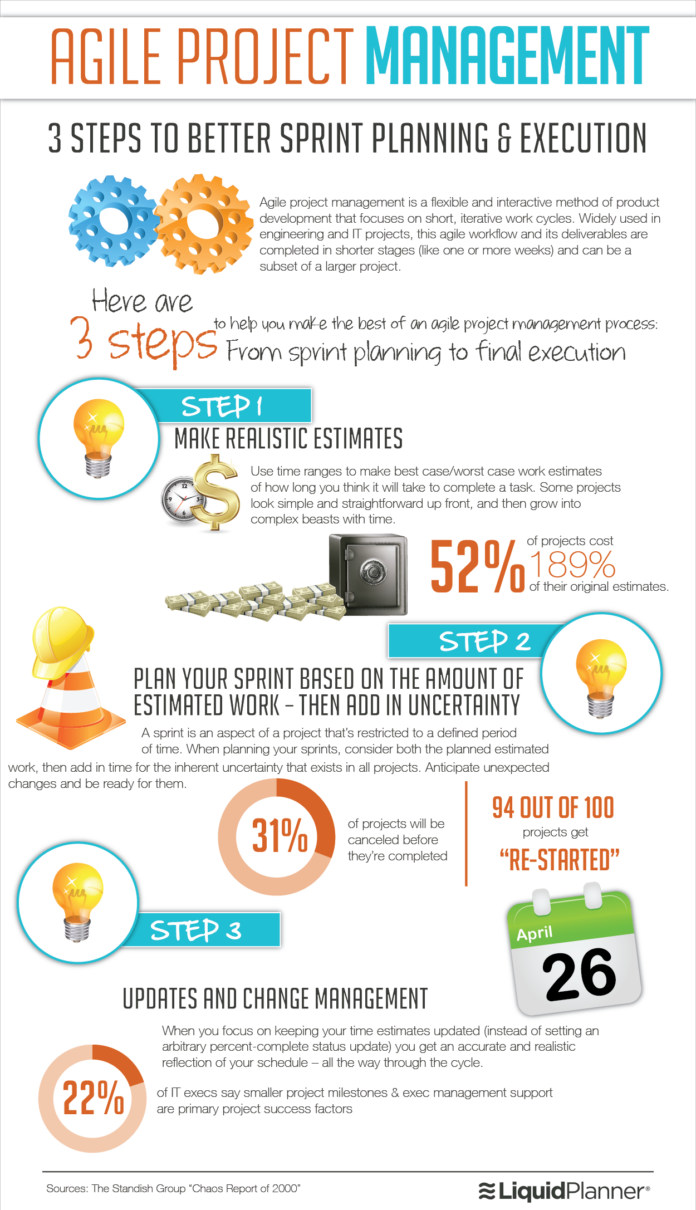Download Free PDF Guide: Agile Fundamentals for Project Managers
What is Agile?
Agile is an approach to building products or services by EMPOWERING and TRUSTING people, acknowledging CHANGE AS normal, and promoting CONSTANT FEEDBACK.
Agile is a PHILOSOPHY that uses organizational models based on people, collaboration and shared values. Agile uses rolling wave planning; iterative and incremental delivery; rapid and flexible response to change; and open communication between teams, stakeholders, and customers.
Agile is a MINDSET. established through 4 VALUES, grounded by 12 PRINCIPLES & manifested through many DIFFERENT PRACTICES
What are the 4 Agile Values?
- Individuals and interactions over processes and tools
- Working software over comprehensive documentation
- Customer collaboration over contract negotiation
- Responding to change by following a plan
What are the 12 Principles of Agile Project Management?
- Our highest priority is to satisfy the customer through the early and continuous delivery of valuable software.
- Welcome changing requirements, even late in development. Agile processes harness change for the customer’s competitive advantage.
- Deliver working software frequently, from a couple of weeks to a couple of months, with a preference for a shorter timescale.
- Business people and developers must work together daily throughout the project.
- Build projects around motivated individuals. Give them the environment and support they need, and trust them to get the job done.
- The most efficient and effective method of conveying information to and within a development team is face-to-face conversation.
- Working software is the primary measure of progress.
- Agile processes promote sustainable development. The sponsors, developers, and users should be able to maintain a constant pace indefinitely.
- Continuous attention to technical excellence and good design enhances agility.
- Simplicity–the art of maximizing the amount of work not done–is essential.
- The best architectures, requirements, and designs emerge from self-organizing teams.
- At regular intervals, the team reflects on how to become more effective, then tunes and adjusts its behavior accordingly.
Agile Practices Examples:
- Time-boxing
- Retrospective
- Spike Solution
- Planning Poker
- Backlog Prioritization
- Progress Elaboration
- Minimal Marketable Features
- Personas
- Story Mapping
- User Stories
- Product Backlog
- Visualize Workflow
- Wireframe
- Daily Stand-up
- Limit Work in Progress (WIP)
- Avoid Waste
- Short Iterations
- Sprint Goals
- Servant Leader
- Self -organization
- Team Agreements
- Release Goals
- Release Plan
- Project Chartering
- Quality Assurance
- Refactoring
- Relative Sizing
- Product Vision
- Pair Programming
- Face-to-Face Conversation
- Osmotic Communication
- Test Driven Development (TDD)
- Velocity
- Unit Testing
- Test First Development
- Technical Debt
- Task board
- Swarming
- Regression Test
- Minimum Viable Product
- Last Responsible Moment (LRM)
Why is Agile Important in Project Management?
- Accelerate time to market
- Managing change priorities
- Better align IT/Business
- Increase productivity
- Enhance software quality
- Reduce cost
- Enhance software maintainability
- Improve team morale
- Improve/increase engineering discipline
- Project visibility
- Reduce risk
- Simplify development process
Top 50 Agile Project Manager Interview Questions and Answers
This video on “Agile Project Manager Interview Questions” brings to you the most frequently asked in Agile Project Manager interviews.


